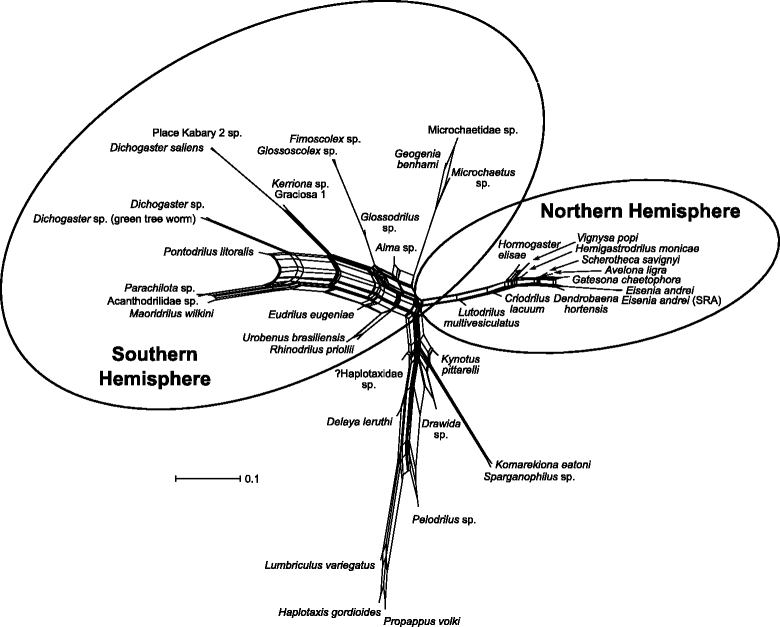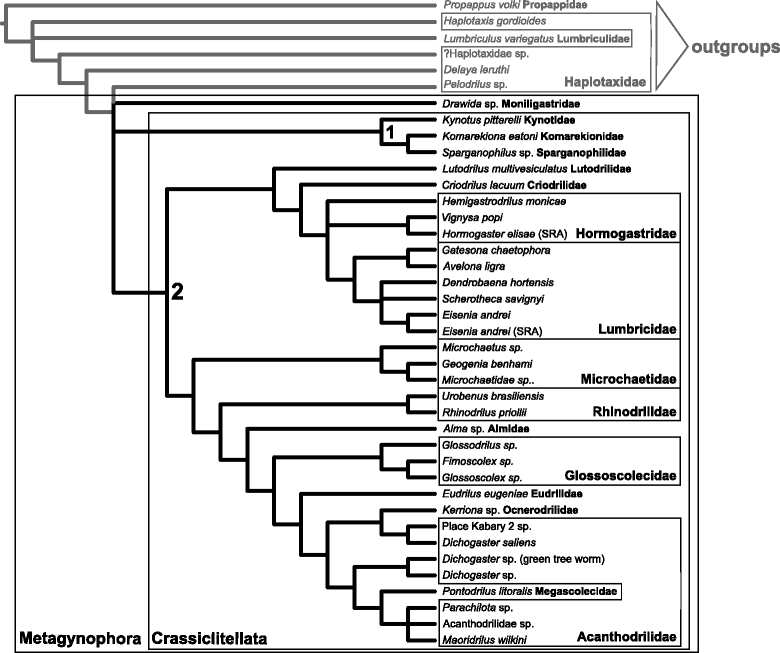Phylogenomic analyses of Crassiclitellata support major Northern and Southern Hemisphere clades and a Pangaean origin for earthworms
- PMID: 28558722
- PMCID: PMC5450073
- DOI: 10.1186/s12862-017-0973-4
Phylogenomic analyses of Crassiclitellata support major Northern and Southern Hemisphere clades and a Pangaean origin for earthworms
Erratum in
-
Erratum to: Phylogenomic analyses of Crassiclitellata support major Northern and Southern hemisphere clades and a Pangaean origin for earthworms.BMC Evol Biol. 2017 Aug 25;17(1):204. doi: 10.1186/s12862-017-1042-8. BMC Evol Biol. 2017. PMID: 28841842 Free PMC article. No abstract available.
Abstract
Background: Earthworms (Crassiclitellata) are a diverse group of annelids of substantial ecological and economic importance. Earthworms are primarily terrestrial infaunal animals, and as such are probably rather poor natural dispersers. Therefore, the near global distribution of earthworms reflects an old and likely complex evolutionary history. Despite a long-standing interest in Crassiclitellata, relationships among and within major clades remain unresolved.
Methods: In this study, we evaluate crassiclitellate phylogenetic relationships using 38 new transcriptomes in combination with publicly available transcriptome data. Our data include representatives of nearly all extant earthworm families and a representative of Moniligastridae, another terrestrial annelid group thought to be closely related to Crassiclitellata. We use a series of differentially filtered data matrices and analyses to examine the effects of data partitioning, missing data, compositional and branch-length heterogeneity, and outgroup inclusion.
Results and discussion: We recover a consistent, strongly supported ingroup topology irrespective of differences in methodology. The topology supports two major earthworm clades, each of which consists of a Northern Hemisphere subclade and a Southern Hemisphere subclade. Divergence time analysis results are concordant with the hypothesis that these north-south splits are the result of the breakup of the supercontinent Pangaea.
Conclusions: These results support several recently proposed revisions to the classical understanding of earthworm phylogeny, reveal two major clades that seem to reflect Pangaean distributions, and raise new questions about earthworm evolutionary relationships.
Keywords: Clitellata; Crassiclitellata; Earthworm; Phylogenomics.
Figures




Similar articles
-
Erratum to: Phylogenomic analyses of Crassiclitellata support major Northern and Southern hemisphere clades and a Pangaean origin for earthworms.BMC Evol Biol. 2017 Aug 25;17(1):204. doi: 10.1186/s12862-017-1042-8. BMC Evol Biol. 2017. PMID: 28841842 Free PMC article. No abstract available.
-
Complete mitochondrial genome of four pheretimoid earthworms (Clitellata: Oligochaeta) and their phylogenetic reconstruction.Gene. 2015 Dec 15;574(2):308-16. doi: 10.1016/j.gene.2015.08.020. Epub 2015 Aug 17. Gene. 2015. PMID: 26291739
-
Phylogenomic analyses of a Mediterranean earthworm family (Annelida: Hormogastridae).Mol Phylogenet Evol. 2016 Jan;94(Pt B):473-478. doi: 10.1016/j.ympev.2015.10.026. Epub 2015 Oct 31. Mol Phylogenet Evol. 2016. PMID: 26522608
-
Diversity and Abundance of Delineated Earthworm (Annelida: Clitellata) in Pakistan: A Review.J Oleo Sci. 2022;71(6):839-834. doi: 10.5650/jos.ess22018. J Oleo Sci. 2022. PMID: 35661065 Review.
-
Nuclear phylogenomics of angiosperms and insights into their relationships and evolution.J Integr Plant Biol. 2024 Mar;66(3):546-578. doi: 10.1111/jipb.13609. Epub 2024 Jan 30. J Integr Plant Biol. 2024. PMID: 38289011 Review.
Cited by
-
Buried treasure in a public repository: Mining mitochondrial genes of 32 annelid species from sequence reads deposited in the Sequence Read Archive (SRA).PeerJ. 2023 Nov 29;11:e16446. doi: 10.7717/peerj.16446. eCollection 2023. PeerJ. 2023. PMID: 38047014 Free PMC article.
-
Concentration- and time-dependent behavioural effects of ethanol on Lumbriculus variegatus.Genes Brain Behav. 2024 Oct;23(5):e70006. doi: 10.1111/gbb.70006. Genes Brain Behav. 2024. PMID: 39407413 Free PMC article.
-
Mitogenome of a stink worm (Annelida: Travisiidae) includes degenerate group II intron that is also found in five congeneric species.Sci Rep. 2022 Mar 15;12(1):4449. doi: 10.1038/s41598-022-08103-5. Sci Rep. 2022. PMID: 35292662 Free PMC article.
-
Mitochondrial Genome Evolution in Annelida-A Systematic Study on Conservative and Variable Gene Orders and the Factors Influencing its Evolution.Syst Biol. 2023 Aug 7;72(4):925-945. doi: 10.1093/sysbio/syad023. Syst Biol. 2023. PMID: 37083277 Free PMC article.
-
Systematic revision of Gatesona (Crassiclitellata, Lumbricidae), an endemic earthworm genus from the Massif Central (France).PLoS One. 2021 Sep 2;16(9):e0255978. doi: 10.1371/journal.pone.0255978. eCollection 2021. PLoS One. 2021. PMID: 34473718 Free PMC article.
References
-
- Darwin C. The formation of vegetable mould, through the action of worms, with observations on their habits. London: J. Murray; 1892.
-
- Cunha L, Brown GG, Stanton DWG, Da Silva E, Hansel FA, Jorge G, et al. Soil animals and pedogenesis: the role of earthworms in anthropogenic soils. Soil Sci. 2016;181:110–125. doi: 10.1097/SS.0000000000000144. - DOI
-
- Hendrix PF, Callaham MA, Drake JM, Huang C-Y, James SW, Snyder BA, et al. Pandora’s box contained bait: the global problem of introduced earthworms. Annu Rev Ecol Evol Syst. 2008;39:593–613. doi: 10.1146/annurev.ecolsys.39.110707.173426. - DOI
-
- Blakemore, RJ American earthworms (Oligochaeta) from North of Rio Grande—a species checklist. A series of searchable texts on earthworm biodiversity, ecology and systematics from various regions of the world, 2nd edn. COE Soil Ecology Research Group, Yokohama National University, Japan. 2006;1-16.
MeSH terms
Substances
LinkOut - more resources
Full Text Sources
Other Literature Sources

